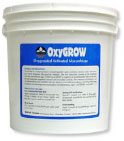TTAB Finds "OXYGROW" and "AUXIGRO" Confusingly Similar for Fertilizer
Relying on Petitioner Emerald Bioagriculture's linguistics expert, the Board found the marks OXYGROW and AUXIGRO to be virtually identical in pronunciation and, when used for overlapping goods (chemical compositions for enhancing plant growth), confusingly similar. The Board therefore granted Emerald's Section 2(d) petition for cancellation of the OXYGROW registration. Emerald Bioagriculture Corp. v. Biosafe Systems, LLC, Cancellation No. 92042503 (February 9, 2006) [not citable].
 Because each party in this cancellation proceeding owned a registration for its respective mark, the Board first observed that Petitioner Emerald must establish priority of use; in other words, the registrations of the parties offset each other. However, each party may rely on its registration for the limited purpose of proving that its mark was in use as of the application filing date. Brewski Beer Co. v. Brewski Bros., Inc., 47 USPQ2d 1281 (TTAB 1998).
Because each party in this cancellation proceeding owned a registration for its respective mark, the Board first observed that Petitioner Emerald must establish priority of use; in other words, the registrations of the parties offset each other. However, each party may rely on its registration for the limited purpose of proving that its mark was in use as of the application filing date. Brewski Beer Co. v. Brewski Bros., Inc., 47 USPQ2d 1281 (TTAB 1998).Here, Emerald's registration was based on an application filed on March 27, 1997. Respondent Biosafe Systems testified that it first use its mark "somewhere around 2001." Therefore, Emerald had priority.
The critical issue in the Board's du Pont analysis was the first factor: the similarity of the marks. Emerald's expert testified that
"in normal speech most speakers of North American English would pronounce these two words as homophones, that is, identically or with only slight and largely imperceptible difference in the initial vowels, and ... most hearers would perceive no difference between the two words without visual clues."
The Board agreed that the marks "would be pronounced by many, if not most, prospective purchasers virtually identically."
As to appearance, the Board found certain similarities: each mark contains seven letters, ends with a "gro[w]", and has an "X" in the middle. However, it not surprisingly agreed that "the overall spelling of the words is different."
As to meaning, the Board noted that neither mark is a common English word, but "[a]s pronounced, their meanings would be indistinguishable." With regard to commercial impression, "it is likely that they would suggest 'oxygen' and 'growing' in the context of fertilizer."
The Board concluded that, "[o]verall, the marks are similar because their pronunciations are virtually identical and their meanings and commercial impressions would be somewhat similar."

Turning to the goods, the Board found them to be "at least in part, virtually identical." Because there are no limitations in the identifications of goods, the Board assumed that the goods travel in all normal channels of trade, to an overlapping class of customers. Nothing in the identifications of goods indicated that the purchasers would necessarily be sophisticated.
As to the "decisive" issue -- the similarity of the marks -- the Board once again pointed out that, because the goods involved are in part virtually identical, the degree of similarity between the marks necessary to support a finding of likely confusion is decreased. The Board ruled that "[t]he marks here are phonetically identically [sic]."
"While fertilizer is not necessarily always purchased by verbally ordering the product, these products would be discussed among farmers, gardeners, and others. Radio and television could be used to promote these products as well as to report news about the products. The pronunciation of the marks would be virtually identically [sic (again)] and confusion under these circumstances would be likely."The Board therefore granted the petition for cancellation.
TTABlog comment: I guess I'm in the minority, because I would pronounce the prefix "oxy" like the word "Bob" (i.e., with a soft "ahhh" sound), but the prefix "auxi" like the word "talk" or "hawk" (with an "aw" sound). But then, I grew up on the South Side of Chicago, the heartland of correct pronunciation. Bostonians, however, pronounce "Bob" as "bawb," so they might pronounce OXYGROW and AUXIGRO in the same way. So maybe these marks are confusingly similar in Boston, but not elsewhere?
Do regional dialects play any part in the Board's 2(d) analysis? What if the marks in question are pronounced alike only in one region of the country? In less than half the country? By only a certain ethnic group?
And how does this decision fit with the Board's oft-stated principle that there is no correct pronunciation of a trademark? (See, for example, the ISHINE case discussed here and the AMAVIO case discussed here).
Text Copyright John L. Welch 2006.




0 Comments:
Post a Comment
<< Home